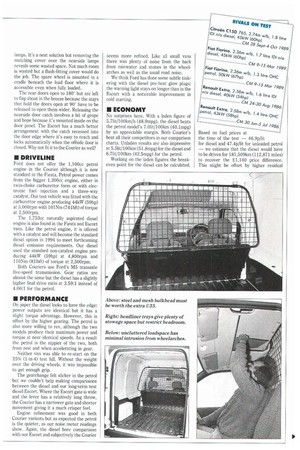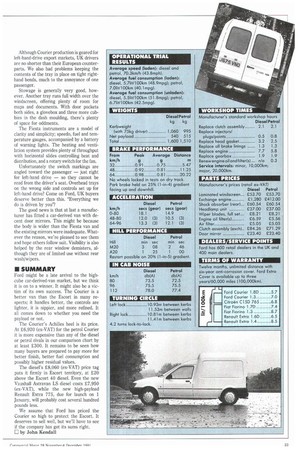• In France they really like them, in Italy and
Page 32

Page 33

Page 34

Page 35

If you've noticed an error in this article please click here to report it so we can fix it.
Spain they're pretty keen on them, but in the UK we're not so sure. It's those sundrenched Mediterraneans who really go in for high-cube vans; we northern Europeans generally prefer something a bit bigger. Mind you, if Ford or Vauxhall had entered the market some years ago, it might have been different.
Ford's belated entry with the Fiestabased Courier is bound to generate interest in this van segment, although more than 75% of the Dagenham-built vehicles are destined for export. Ford acknowledges that it will lose some Escort van sales to its new entrant but hopes the loss will be minimal. The company plans to shift around 7,500 Couriers in the UK next year.
Like the Escort, two trim levels are available — Popular and Standard — with a choice of petrol or diesel engines. Ford lists only two optional extras; a half-height steel bulkhead with mesh top section at £35 (exVAT) and metallic paint, available on Standard models only, at £150.
The choice between engines is less clear cut with vehicles of this size than further up the weight range. The petrol derivatives are reasonably fuel efficient so the additional cost of the diesel takes longer to recoup. We decided to test both petrol and diesel Couriers. To help distinguish between the two, Ford supplied us with a white petrol model and a white diesel.
• BODYWORK
Ford claims a best-in-class body volume of 2.8m, but measured to DIN standards it achieves only 2.5rn, which is the figure we have quoted in our comparison charts. That loss of 0.3m takes the volume from the top to the bottom of our chart, but begs the question, how are its rivals measured? We think it's about time all manufacturers quoted the same measuring standard so a direct comparison could be made.
The space itself is, surprise, surprise, boxy. Like its bigger brothers the Courier has tie-down eyes in the load floor; six in all. The floor is covered with a rubber mat, Escort style. The half-height bulkhead is a worthwhile option for keeping the load at bay: the double vertical bars behind the driver's seat in the petrol model wouldn't be too effective against flying parcels.
The wheelarches inevitably intrude into such a small vehicle, but no more than in its rivals. The toolkit and jack are stowed behind a plastic cover over the offside rear lamps. It's a neat solution but removing the matching cover over the nearside lamps reveals some wasted space. Not much room is wasted but a flush-fitting cover would do the job. The spare wheel is mounted in a cradle beneath the load floor where it is accessible even when fully loaded.
The rear doors open to 1800 but are left to flap about in the breeze because the stays that hold the doors open at 900 have to be released to open them wider. Releasing the nearside door catch involves a bit of grope and hope because it's mounted inside on the door panel. The Escort has a much better arrangement with the catch recessed into the door edge where it's easy to reach and locks automatically when the offside door is closed. Why not fit it to the Courier as well?
• DRIVELINE
Ford does not offer the 1,100cc petrol engine in the Courier although it is now standard in the Fiesta. Petrol power comes from the bigger 1,300cc engine, either in twin-choke carburettor form or with electronic fuel injection and a three-way catalyst. Our test vehicle was fitted with the carburettor engine producing 44kW (59hp) at 5,000rpm with 101Nm (741bft) of torque at 2,500rpm.
The 1,753cc naturally aspirated diesel engine is also found in the Fiesta and Escort vans. Like the petrol engine, it is offered with a catalyst and will become the standard diesel option in 1994 to meet forthcoming diesel emission requirements. Our diesel used the standard non-catalyst engine producing 44kW (59hp) at 4,800rpm and 110Nm (81lbft) of torque at 2,500rpm.
Both Couriers use Ford's M5 transaxle five-speed transmission. Gear ratios are almost the same but the diesel has a slightly higher final drive ratio at 3.59:1 instead of 4.06:1. for the petrol.
• PERFORMANCE
On paper the diesel looks to have the edge: power outputs are identical but it has a slight torque advantage. However, this is offset by the higher gearing. The petrol is also more willing to rev, although the two models produce their maximum power and torque at near identical speeds. As a result the petrol is the nippier of the two, both from rest and when accelerating in gear.
Neither van was able to re-start on the 25% (1-in-4) test hill. Without the weight over the driving wheels, it was impossible to get enough grip.
The gearchange felt slicker in the petrol but we couldn't help making comparisions between the diesel and our long-term test diesel Escort. Where the Escort gate is wide and the lever has a relatively long throw, the Courier has a narrower gate and shorter movement giving it a much crisper feel.
Engine refinement was good in both Courier variants but as expected the petrol is the quieter, as our noise meter readings show. Again, the diesel bore comparision with our Escort and subjectively the Courier seems more refined. Like all small vans there was plenty of noise from the back from rainwater and stones in the wheelarches as well as the usual road noise.
We think Ford has done some subtle tinkering with the diesel pre-heat glow plugs; the warning light stays on longer than in the Escort with a noticeable improvement in cold starting.
• ECONOMY
No surprises here. With a laden figure of 5.7lit/100km/h (48.9mpg), the diesel beats the petrol model's 7.01it/1001cm (40.1mpg) by an appreciable margin. Both Courier's beat all their competitors in our comparison charts. Unladen results are also impressive at 5.5lit/100km (51.8mpg) for the diesel and 6.71it/100Iun (42.5mpg) for the petrol.
Working on the laden figures the breakeven point for the diesel can be calculated.
Citroen C15D 763, 2.74m wth, 1.8 litre 1Di n/a diesel, 45k W (60hp) .......................... n/a CM 28 Sept-4 Oct 1989. Fiat Florin°, 2.36m w/b, 1.7 litre /DJ diesel, 45kW (60hpi ................................. CM 9-15 Mar 1989 Fiat Florin°, 2.36m w/b, 1.3 litre OHC petrof, 50kW (67hp) ................................. CM 9-15 Mar 7989. RenaultExtra, 2.58m w/b, 1.6 litre Of n/a diesel, 40kW (54hp) ............................... CM 24-30 petrol43kW ( Aug 1986.i Renault Extra, 258h.58m w/b, 1.4 litre OHC
, pl .............................. CM 30 Jun-5 Jul /986. ............................................................ Based on fuel prices at the time of the test — 46.9p/lit for diesel and 47.4p/lit for unleaded petrol — we estimate that the diesel would have to be driven for 181,509km (112,871 miles) to recover the E1,140 price difference. This might be offset by higher residual values for the diesel version. As diesel is arguably a more environmentally friendly fuel, we feel that it ought to carry a lower tax burden to encourage its use. But meanwhile, that high payback mileage is likely to encourage many buyers to opt for the lower cost petrol van.
Of the high-cube vans we have tested, only the Seat Terra diesel (CM 28 Jun-4 Jul 1990) returned better fuel consumption than the diesel Courier with a laden result of 5.71it/100Iun (49,2mpg). The Terra's economy is gained at the expense of performance, however.
Neither Courier should present servicing problems. Access to routine service items is good on both, except the oil filter on the diesel. Tucked away behind the engine, next to the exhaust manifold, it's difficult to reach. For those who don't want the challenge, Ford dealers are plentiful.
• HANDLING
The front end of the Courier is pure Fiesta, with typical Ford MacPherson strut suspension. For the back Ford has developed an all-new suspension system. Instead of adapting the leaf-spring suspension from the Escort, it has produced a transverse torsion bar system. Ford says that this reduces intrusion into the load space.
Dampers are inclined too, so the top mount does not protrude above floor level. The system includes an anti-roll bar and polyurethane spring assisters.
When fully laden no car-derived van feels particularly happy if it is pushed to its limits on the track. The Couriers both felt distinctly twitchy, but the extra steering weight made the diesel feel slightly more stable. We thought that the Escort's highspeed handling unpredictability might show up with the Couriers; in practice, it will just push its nose wide. Lifting off doesn't induce snap-on oversteer, just a tightening of the line.
The brakes performed well in our panicstop testing, providing excellent retardation. The Courier pulled up straight each time with the front wheels locked.
• INTERIOR
The Courier cab is surprisingly roomy, with plenty of room for drivers over six feet. Unfortunately, headroom is restricted by the tray over the driver's seat. Other highcube vans, like the Renault Extra, also have this useful feature, but the tray is over the passenger seat, Although Courier production is geared for left-hand-drive export markets, UK drivers are no shorter than their European counterparts. We also had problems keeping the contents of the tray in place on tight righthand bends, much to the annoyance of one passenger.
Stowage is generally very good, however. Another tray runs full width over the windscreen, offering plenty of room for maps and documents. With door pockets both sides, a glovebox and three more cubbies in the dash moulding, there's plenty of space for oddments.
The Fiesta instruments are a model of clarity and simplicity; speedo, fuel and temperature gauges, accompanied by a battery of warning lights. The heating and ventilation system provides plenty of throughput with horizontal slides controlling heat and distribution, and a rotary switch for the fan.
Unfortunately the switch markings are angled toward the passenger just right for left-hand drive so they cannot be read from the driver's seat. Overhead trays on the wrong side and controls set up for left-hand drive? Come on Ford, UK buyers deserve better than this. "Everything we do is driven by you"?
The good news is that at last a manufacturer has fitted a car-derived van with decent door mirrors. This might be because the body is wider than the Fiesta van and the existing mirrors were inadequate. Whatever the reason, we're pleased to see them and hope others follow suit. Visibility is also helped by the rear window demisters, although they are of limited use without rear wash/wipers,
• SUMMARY
Ford might be a late arrival to the highcube car-derived-van market, but we think it is on to a winner. It might also be a victim of its own success. The Courier is a better van than the Escort in many respects; it handles better, the controls are lighter, it is nippier, and more refined. It all comes down to whether you need the payload or not.
The Courier's Achilles heel is its price_ At £6,920 (ex-VAT) for the petrol Courier it is more expensive than any of the diesel or petrol rivals in our comparison chart by at least £300. It remains to be seen how many buyers are prepared to pay more for better finish, better fuel consumption and possibly higher residual values.
The diesel's £8,060 (ex-VAT) price tag puts it firmly in Escort territory, at £20 above the Escort 40 diesel. Even the new Vauxhall Astravan LS diesel costs £7,950 (ex-VAT), while the new high-payload Renault Extra 775, due for launch on 1 January, will probably cost several hundred pounds less.
We assume that Ford has priced the Courier so high to protect the Escort. It deserves to sell well; but we'll have to see if the company has got its sums right.
Li by John Kendall


























































































